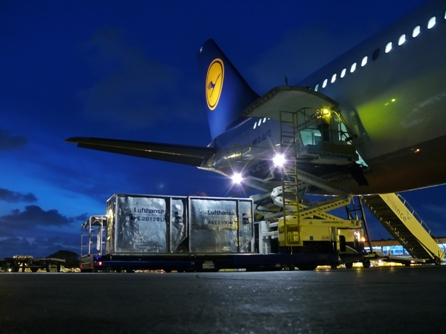There have been some dramatic figures in the air cargo business in the past two or three months. It cannot be often that a major airport gets to report a 36.7% rise in cargo volumes, as Hong Kong did for the first two months of this year, or that airlines can claim a 28% rise, which was the IATA cargo traffic figure for the same period.
But these figures are, of course, year on year comparisons with the start of 2009, when world trade seemed to be in freefall, and air cargo with it. Falls of 20-30% in cargo traffic were widespread for the world's airlines in the first half of 2009, and the third quarter was not much better. But then air cargo showed its fabled ability to bounce back. This was particularly evident in November, when IATA reported a 9.5% year on year rise, and in December, when traffic leapt 24.4%.
Back to normal then? Well, only partly. Hong Kong and its Chinese hinterland has been at the heart of the recovery, and its sharp rise in January and February of this year does put it back just above where it was pre-crisis in 2008. But not everywhere is doing as well. IATA shows Asian carriers as a whole 37.2% up year on year in January and February, and US carriers up 32.9%, but European operators are noticeably trailing on just 9.3%.
 |
|---|
©Lufthansa Cargo |
Even in Asia, there is a lot of nervousness. "Everyone remains pretty cautious," says Rupert Hogg, director of cargo for Cathay Pacific. "We don't know if the world economy is going into a double dip." As a result, he is taking a cautious view on capacity. He did bring two of the five Boeing 747-400 freighters Cathay had parked back from the desert earlier this year, but that was to prepare for the launch of Cathay's cargo joint venture with Air China, which is slated for July or August. He is in no hurry to bring back further capacity just yet.
This caution is also in evidence at other major carriers such as Star Alliance carrier Lufthansa, which is preparing two of its parked Boeing MD-11Fs for service, but insists no decision has yet been taken if to deploy them. The big question is whether the restraint will last if the recovery starts to look more long-lasting.
Keeping the lid on capacity growth matters because while tonnage may have returned to something approaching normal levels, yields have not. The fourth quarter saw definite improvement, but rates still remain below pre-crisis levels. Lufthansa Cargo was not untypical in losing a third of its revenue in the year to March, creating a record €171 million ($234 million) operating loss. Its chairman Carsten Spohr predicts that it will not return to profit until 2011.
Rethinking Freighter Operations
The fall in yield has left some large carriers wondering if they should be in the business of operating all-cargo aircraft at all. A prominent example is restructuring Japan Airlines, which in March announced its withdrawal from dedicated freighter operations after 51 years in the business. Just a few years ago, JAL was a substantial cargo player, with a fleet of 12 Boeing 747Fs, and so was Northwest Airlines, with 13 of the aircraft. Yet Neel Shah, head of cargo for Delta Air Lines, expressed undisguised relief when it sent the last Northwest freighter packing last year.
One could have accused both of these carriers of being overdependent on older less fuel-efficient aircraft, but that could not be said of Air France or KLM, which both invested in the newest equipment. Air France was the launch customer of the Boeing 777 freighter, ordering five. But it has taken delivery of only two, and sold two more to FedEx. It also invested in four Boeing 747-400ERFs, touted at its launch in 2001 as the latest in operating economics, but has now leased two of them to Russia's AirBridge Cargo. Meanwhile KLM has exited freighter operations altogether by transferring its four Boeing 747-400ERFs to Martinair, which is using them to replace older freighters.
That reduces the Air France-KLM cargo fleet from 16 Boeing 747Fs just a couple of years ago to five today - a move motivated by a steely determination to get its cargo yields back up to acceptable levels. The carrier also says a factor has been the large amount of belly capacity entering its fleet - for example, through the cargo-friendly Boeing 777-300ER.
This is reminiscent of the American airline industry in the late 1970s and early 1980s, where falling yields caused most US majors to abandon their cargo fleets to focus on belly cargo. But it would be an exaggeration to say that this is a major trend in the air cargo sector. Air France's capacity loss was after all AirBridge Cargo's gain, and that carrier is buoyant, planning new routes and looking forward to growth.
At Cathay, Hogg admits that with next generation freighters such as the Boeing 777F or 747-8F requiring serious investment, boardrooms now demand a much tighter business case for freighter operations. But he still thinks all-cargo aircraft make plenty of sense and that there will be plenty of demand to fill the ten 747-8Fs on the way to the airline in 2011 and 2012.
And Ulrich Ogiermann, chief executive of Cargolux, also about to get 747-8Fs, agrees. "We realise that in a downturn belly production is cheaper as it is a natural by product of the passenger business. But as markets grow again the need to de-link from the bellies becomes apparent," he says. "In most of the markets Cargolux operates there is a need for freighters, due to demand or the dimensions of the shipments. So we are still convinced that we have the right product."
For more on cargo trends go to McKinsey's analysis in the April issue of Airline Business
Source: Airline Business



















